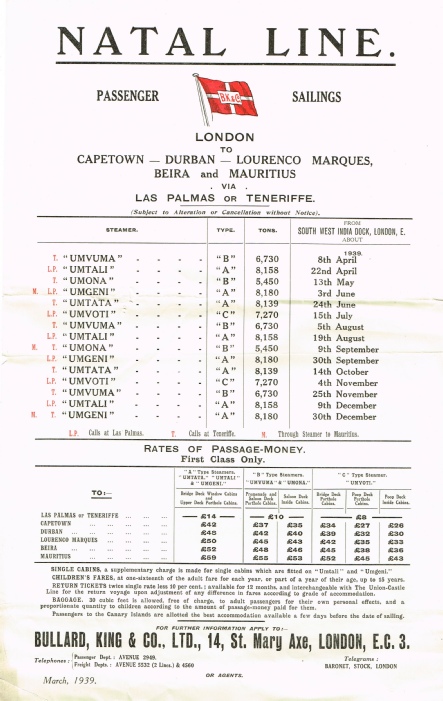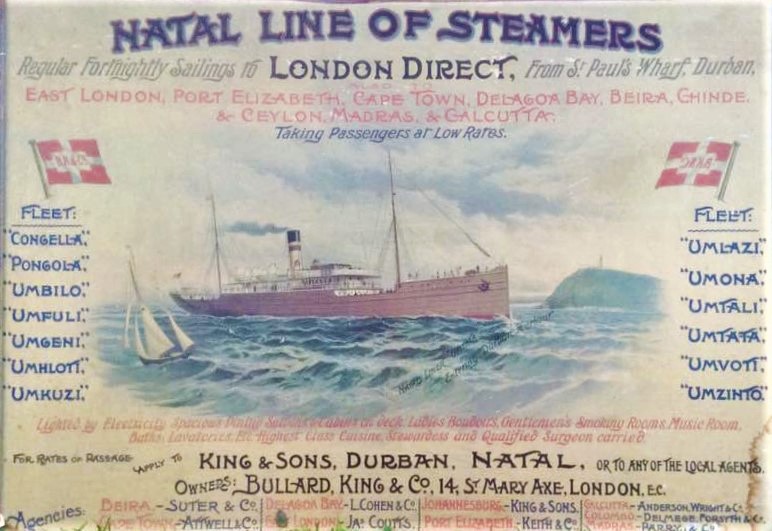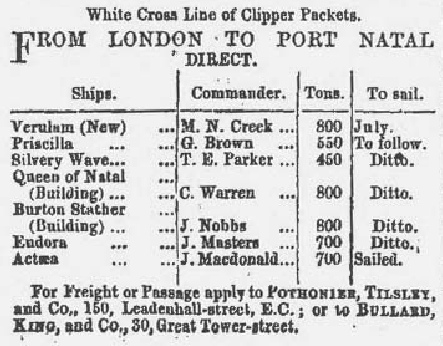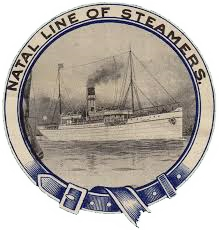





Vessel |
1870s |
1880s |
1890s |
1900s |
1910s |
1920s |
1930s |
1940s |
1950s |
|
Pongola |
|
|
|
|
|
|
|
|
|
|
Limpopo |
|
|
|
|
|
|
|
|
|
|
Congella |
|
|
|
|
|
|
|
|
|
|
Umtata 1 |
|
|
|
|
|
|
|
|
|
|
Palala 2 |
|
|
|
|
|
|
|
|
|
|
Umzinto 1 |
|
|
|
|
|
|
|
|
|
|
Umlazi 1 |
|
|
|
|
|
|
|
|
|
|
Umvolosi 1 |
|
|
|
|
|
|
|
|
|
|
Umbilo |
|
|
|
|
|
|
|
|
|
|
Umhloti |
|
|
|
|
|
|
|
|
|
|
Umkuzi 1 |
|
|
|
|
|
|
|
|
|
|
Umona 1 |
|
|
|
|
|
|
|
|
|
|
Umfuli |
|
|
|
|
|
|
|
|
|
|
Umtali 1 |
|
|
|
|
|
|
|
|
|
|
Umvoti 1 |
|
|
|
|
|
|
|
|
|
|
Umgeni 1 |
|
|
|
|
|
|
|
|
|
|
Umtata 2 |
|
|
|
|
|
|
|
|
|
|
Umsinga |
|
|
|
|
|
|
|
|
|
|
Umvolosi 2 |
|
|
|
|
|
|
|
|
|
|
Umhlali |
|
|
|
|
|
|
|
|
|
|
Umzumbi |
|
|
|
|
|
|
|
|
|
|
Umona 2 |
|
|
|
|
|
|
|
|
|
|
Umvuma |
|
|
|
|
|
|
|
|
|
|
Umlazi 2 |
|
|
|
|
|
|
|
|
|
|
Umzinto 2 |
|
|
|
|
|
|
|
|
|
|
Umkuzi 2 |
|
|
|
|
|
|
|
|
|
|
Umvoti 2 |
|
|
|
|
|
|
|
|
|
|
Umtata 3 |
|
|
|
|
|
|
|
|
|
|
Umtali 2 |
|
|
|
|
|
|
|
|
|
|
Umgeni 2 |
|
|
|
|
|
|
|
|
|
|
Umtata 4 |
|
|
|
|
|
|
|
|
|
|
Umzinto 3 |
|
|
|
|
|
|
|
|
|
|
Umkuzi 3 |
|
|
|
|
|
|
|
|
|
|
Umvoti 3 |
|
|
|
|
|
|
|
|
|
|
Umtali 3 |
|
|
|
|
|
|
|
|
|
|
Umgazi |
|
|
|
|
|
|
|
|
|
|
Umgeni 3 |
|
|
|
|
|
|
|
|
|
|
Umzinto 4 |
|
|
|
|
|
|
|
|
|






































|
|
1870s |
1880s |
1890s |
1900s |
1910s |
1920s |
1930s |
1940s |
1950s |
|
18 - 20 |
|
|
|
|
|
|
|
|
|
|
16 - 18 |
|
|
|
|
|
|
|
|
|
|
14 - 16 |
|
|
|
|
|
|
|
|
|
|
12 - 14 |
|
|
|
|
|
|
|
|
|
|
10 - 12 |
|
|
|
|
|
|
|
|
|
|
8 - 10 |
|
|
|
|
|
|
|
|
|
|
6 - 8 |
|
|
|
|
|
|
|
|
|
|
4 - 6 |
|
|
|
|
|
|
|
|
|
|
2 - 4 |
|
|
|
|
|
|
|
|
|
|
0 - 2 |
|
|
|
|
|
|
|
|
|
















